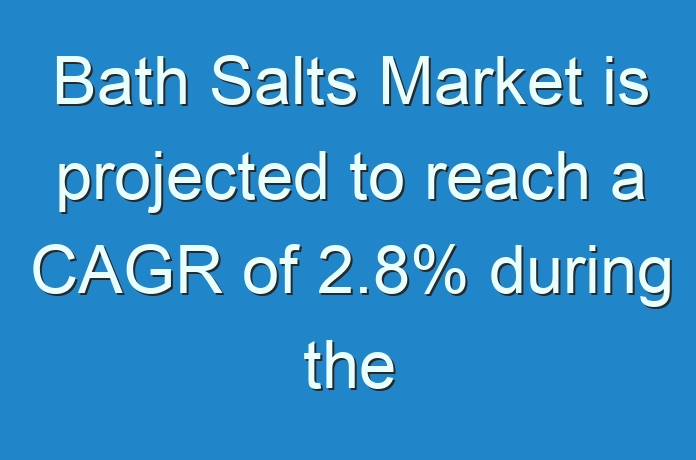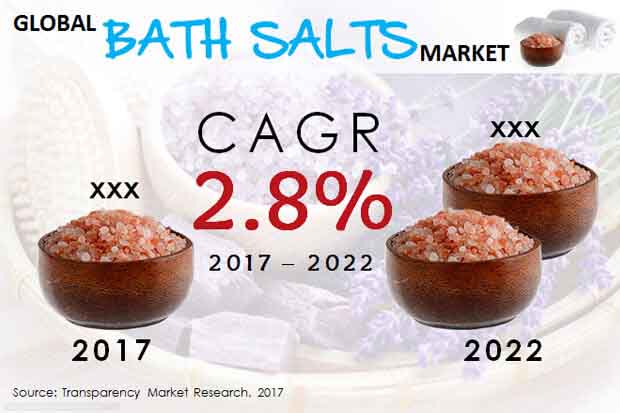
Bath salts are crystalline in form and are used in various applications and are water soluble in nature. Some bath salts like phosphates have detergent action that tempers hardened skin and also helps in cleaning cells of dead skin while some act as water softeners. High bath salt concentrations raise the water density and also increase buoyancy that makes the body to feel lighter when bathing. They are also being researched for treating arthritis. Bath salts are of different types, to name a few, there are Epsom salts, Himalayan salts, Bolivian salts, dendritic salts and Dead Sea salts. The main reason supporting the growth of the bath salts market is their functionality in relaxing the muscles in the human body.
Transparency Market Research has furnished a new research report titled “Bath Salts Market (Product Type – Epsom Salt, Dead Sea Salt, Himalayan Salt, Bolivian Salt, Dendritic Salt, Other Product Types; Distribution Channel – Modern Trade, Drug Stores, Convenience Stores, E-Commerce, Other Distribution Channels; Application – Bath Care, Aromatherapy, Therapeutic, Home Care, Fertilizer, Other Applications; Grade – Fine, Medium, Coarse) – Global Industry Analysis, Share, Size, Growth, Trends and Forecast 2017-2022”, in which numerous factors influencing the growth of the bath salts market are studied across key regions around the globe. As per this research publication, the global market for bath salts is projected to reach a CAGR of 2.8% during the period of assessment, 2017-2024 to reach a significant market valuation by the end of the forecasted year.
Request for a sample:
https://www.transparencymarketresearch.com/sample/sample.php?flag=S&rep_id=33173
5 Key Insights on Global Bath Salts Market
The global bath salts market has been segmented by product type, distribution channel, application, grade and region.
- By distribution channel, the modern trade segment reflects high potential during the assessment period. This segment is the largest segment in terms of market value and also a high growth segment. It is poised to register a comparatively higher CAGR of 3.2% throughout the period of assessment
- By product type, Himalayan salt segment is expected to grow at a higher pace as it experiences a high consumption in the recent years. This segment reflects a high 4.4% CAGR during 2017-2024 and also witnesses a higher gain in the BPS by 2024 end. However, it shows less market share in this period
- By application, the therapeutic segment is the fastest growing and has shown an increase in revenue since past few years. However, the bath care segment is the largest segment with a high market share and is estimated to reach a value of more than US$ 775 Mn by 2024
- By grade, the medium segment is the most lucrative. It has witnessed a high gain in the BPS and is expected to continue this status quo. It is poised to reach a significant CAGR and estimated to reflect a value of about US$ 725 Mn by 2024, thus becoming the largest segment
- By region, Asia Pacific excluding Japan (APEJ) region shows high attractiveness. The bath salt market in the APEJ region is anticipated to reach a comparatively higher market valuation and is expected to grow at a faster rate during the period of assessment. This region has been a first preference for several players in the bath salt market
Ask for brochure:
https://www.transparencymarketresearch.com/sample/sample.php?flag=B&rep_id=33173
Competition Scenario
The research study on global market for bath salts has included various key companies. Their SWOT analysis, product portfolio, developments and financials have been included in this study. Companies such as STENDERS SIA, Kneipp GmbH, Dadakarides Salt SA, Bathclin Corporation, L’Occitane International SA, Shiseido Company Limited, The Unilever Group and Kao Corporation are profiled.
TMR’s Latest News Publication –






